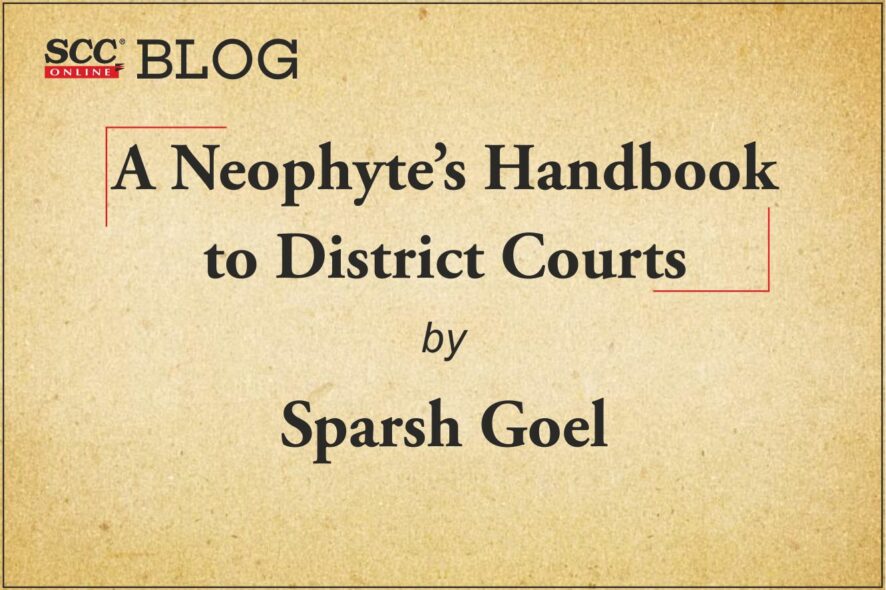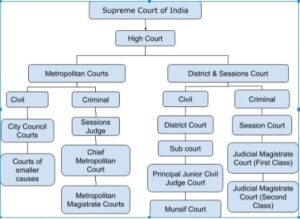District Courts are the first place where a law student starts to explore the nitty-gritty of the legal system in India. Almost every single case or suit finds its genesis in the District Court. Whilst a District Court may be a goldmine for someone alien to the Indian judicial system, this short guide seeks to equip you with a pickaxe to understand it all. This guide will help you in understanding the structure and functioning of courts. Further the physical layout of a courtroom, composition of the court staff, general Urdu calques used and the general structure of the District Court judiciary.
The District Court judiciary is divided broadly into two types – civil and criminal. Further, the classification depends upon the population of the zonal territory (called “the Sessions Division”) and subsequent declaration by the State Government[1]. Thus, the District Judiciary would be, depending on classification as Sessions Division or Sessions Divisions called districts, set up as either of the following:
In addition to the above, Special Courts are courts set up for expeditious resolution of cases that involve special subject-matter. These courts are allocated all cases pertaining to the subject-matter, for which they are set up. For example, an Additional Sessions Court set up for Narcotic Drugs and Psychotropic Substances Act, 19853 (the NDPS Act), would be dealing in matters concerned only with the NDPS Act.4
Court room.—The Bench consists of the Judge in the center, on the right (of the Judge) the reader is situated, right below the Bench is the stenographer and the clerk who handles the drafting of judicial documents. The orderly announces each case as per the cause list (a list of cases to be taken up that day). The orderly sits usually on the side of the reader.
The “reader” ensures the judicial documents are correct, for example, ensuring signatures of witnesses, etc., prepares other judicial documents to aid the Judge, polices everyone’s conduct, guides other staff of the courtroom. The reader is the seniormost court staff member. For any clarifications regarding dates, proceedings, cause list, decrees, etc. he or she may be approached.
The second most senior member, the stenographer (steno) is the “typing hand” of the Judge. Every order/judgment/charge/notice that bears the header of the court, emerges out of the steno’s computer. The Clerk aids the steno in drafting or maintaining documents and ensuring every box is ticked or every document attested, etc.
Court Naib is a police constable, serving as an attaché in the Department of Prosecution who maintains the peshi register (witness register), warrant/FIR register, etc. in the courtroom. In order to know which item number is ongoing or if a witness will come to the court today, he or she can be approached.
Public Prosecutor (PP).—Each criminal court has a separate table located on the right side, when you enter the court, where you will find the State’s legal representative. The PP assists the court in progression of the case and partakes to represent the interests of the State.5
Alhmad room.—This is a separate room with each court, which stores all records of that court. A Alhmad room is under the management of an Ahlmad assisted by two or more assistant Alhmads. An advocate inspects the case file here, after seeking permission of the court.
Dasti.—When it is remarked “Dasti to be given” it means an uncertified copy of the order, given to the party that requests for the same.
Courtroom decorum.—Discarding the cinematic exaggerations, every lawyer that appears before a court and wishes to be granted the prayed relief, places his or her arguments in a patient, calm and cogent manner. However, friendly banter is as common as a friendly Judge.
Rudimentary practices – exemption of appearance/passover.
An application for exemption to appear, is excusal of an accused/co-accused for non-appearance in the court, due to reason stated, usually due to sickness or infirmity.6
A passover is a request for the matter (as a case is called) to be taken up later, at the requested time, or at the end of the cause list.
Oath Commissioner/notary.—A notary is a qualified and experienced lawyer, who is entrusted by the court to authenticate and verify identities, declarations, documents, etc.
Lastly, each District Court premises has:
- A nazarat block aka process serving agency is primarily responsible for delivery/execution of various judicial pronouncements/decrees (summons/notices/warrants, etc.) The execution is generally done of civil decrees, however, it is not a mandate.
- District Legal Services Authority Office.— DSLA is a State-sponsored legal aid authority which offers legal representation to those who cannot afford a lawyer or want a State-sponsored lawyer, to represent them in criminal matters.
- Lockup for undertrials.—Those in custody of the State – be it police or judicial – are kept in this lockup while they await their turn to be produced before a court.
- Lawyers’ block.—This building/set of building contains the chamber of advocates.
- Office of the Bar Association.—Each District Court has its own District Bar Association that has an elected council to decide matters pertaining to the welfare of advocates.
- Facilitation centre/filing counter.—As the name suggests this is where all matters are filed.
- Copying agency.– From here, you can obtain certified copies of judgment/decrees.
- Police station and amenities like canteen, post office, etc.
Citizen charter.—To understand the District Court premises in detail, code of conduct in the court premises or any other information, one can refer to the citizen charter issued by the State at the District Court website.
*Second year student, BA LLB (Hons.), Dr B.R. Ambedkar National Law University. Author can be reached at goelspr@gmail.com.
[1]Code of Criminal Procedure, 1973, Ss. 7-8.
[2]Flowchart Credits, https://www.jagranjosh.com/general-knowledge/subordinate-courts-in-india-1438321965-1, refer Code of Criminal Procedure, 1973, Ss. 15-19.
3Narcotic Drugs and Psychotropic Substances Act, 1985.
4Code of Criminal Procedure, 1973, S. 194.








